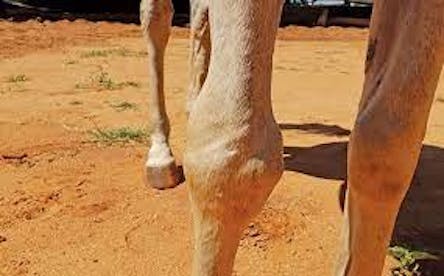Horses do not have knees in the same way humans do. Instead, they have a complex system of joints and bones that allow them to support their weight and move. Here's some information on the horse's equivalent of the knee:
- Fetlock Joint:
This is the equivalent of the human ankle and wrist joint. It's located just above the hoof and is responsible for much of the horse's weight-bearing. Location: The fetlock joint is located on the horse's leg, just above the hoof, and it is equivalent to the metacarpophalangeal joint (front limb) or metatarsophalangeal joint (hind limb) in humans. It's essentially the "ankle" of the horse's leg.
- Structure:
The fetlock joint consists of three main bones: the long pastern bone (proximal phalanx), the short pastern bone (middle phalanx), and the cannon bone (third metacarpal or metatarsal bone). These bones come together to form the joint.
- Function:
The fetlock joint is crucial for bearing the horse's weight and facilitating movement. It acts as a hinge joint that allows for flexion and extension of the horse's limb. During locomotion, the fetlock joint absorbs and dissipates some of the forces generated as the horse moves, helping to reduce stress on the more fragile structures within the limb.
- Pastern Joint: This joint is situated between the fetlock joint and the hoof. It plays a crucial role in shock absorption during locomotion.
- Coffin Joint: Also known as the distal interphalangeal joint, this is the horse's equivalent of the toe joint. It's located within the hoof and is responsible for flexion and extension of the digit.
- Carpus: The carpus is similar to the human wrist but is higher up on the horse's leg. It's the joint that corresponds to what many people think of as the "knee" in a horse. It is composed of several small bones that allow for the flexion and extension of the forelimb.
- Hock Joint: The hock joint is the equivalent of the human ankle, and it's located in the hind limbs. It's a complex joint, composed of several smaller joints, and it plays a significant role in the horse's ability to move and support its weight.
- When people refer to a horse's "knee," they're typically talking about the carpus in the front limbs. The carpus is a vital part of the horse's anatomy as it helps in bearing weight and facilitating movement. It can be prone to injuries, such as sprains or fractures, which can impact a horse's soundness and mobility. Proper care and veterinary attention are essential to maintain a horse's carpal health

knee info...



